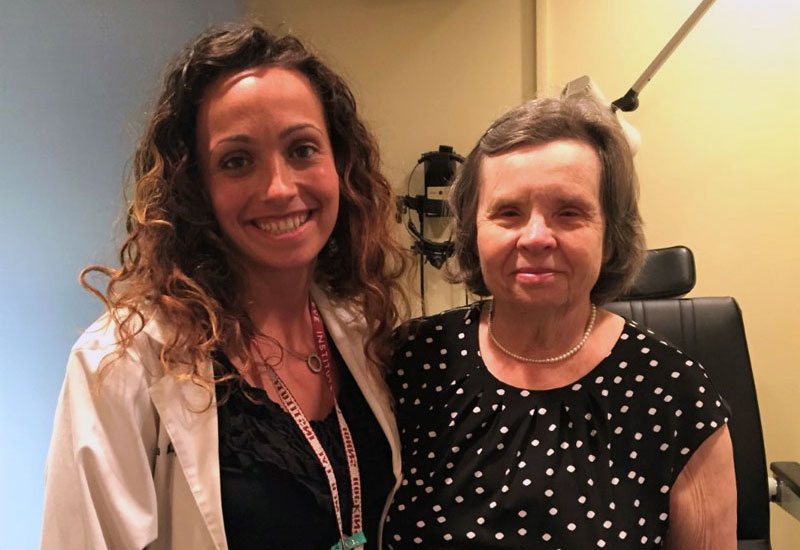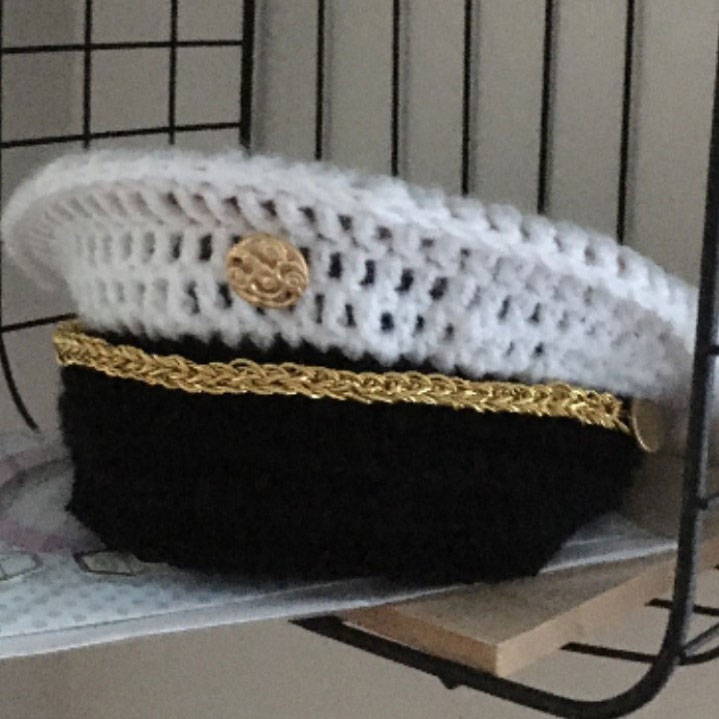Like many women, Antoinette Zelis began to have dry, irritated eyes in middle age. For Zelis, however, the discomfort became extreme: Her eyes were terribly light sensitive, painful even. She sought help at Wilmer Eye Institute, where — like many patients — she benefited from Wilmer’s teamwork approach.
Cornea specialist Divya Srikumaran, M.D., noted that Zelis’ eyes were inflamed, and the conjunctiva — the membrane that lines the inside of the eyelids — was scarred. She diagnosed Zelis with severe dry eye disease.
Esen Akpek, M.D., director of the Ocular Surface Disease and Dry Eye Clinic and the Bendann Family Professor of Ophthalmology at Wilmer, says dry eye disease is different than simply having eye dryness. “Your eyes could feel dry and irritated because you sat at the computer all afternoon without blinking, but dry eye disease can be caused by a number of factors, such as dysfunction of the tear system,” Akpek says. “It could also be a symptom of certain systemic diseases.” Regardless of the cause, untreated dry eye disease can lead to ulcers and perforations of the cornea — the clear outer layer of the eye — as well as scarring and infection.
Srikumaran thought Zelis’ symptoms might indicate mucous membrane pemphigoid (MMP), an autoimmune disorder that can cause blistering and scarring of the conjunctiva. Srikumaran performed a conjunctival biopsy, but it came back negative for MMP.
To relieve Zelis’ symptoms, Jennifer Thorne, M.D., Ph.D., chief of the Division of Ocular Immunology and the Cross Family Professor of Ophthalmology at Wilmer, recommended scleral contact lenses — large-diameter, hard, gas-permeable lenses that sit on the white part of the eye (the sclera) rather than on the cornea like most contact lenses. Scleral lenses “vault” over the cornea, leaving a small reservoir of space between the lens and the cornea that is filled with artificial tears to coat the corneal surface. But Zelis couldn’t bear the thought of putting anything in her irritated eyes and quickly dismissed the idea. Anyway, at her age, learning to put in contact lenses wasn’t something she felt she could handle.
Meanwhile, the list of things that bothered her eyes grew: Wind. Heat. Light. She developed filaments — little particles that attach to the cornea, especially in very dry eyes. To Zelis, it felt like she was constantly blinking over a little piece of glass. Her eyes grew increasingly painful and more difficult to keep open. Thorne referred Zelis to one of the world’s foremost experts on dry eye: Esen Akpek.
A Hidden Epidemic
In the U.S., about 25 million people have dry eye disease (DED). Of those, over half a million have Sjögren’s syndrome, an autoimmune disease that often causes dry mouth and eyes. Akpek, who is the associate director of the Jerome L. Greene Sjögren’s Syndrome Center at Johns Hopkins Bayview Medical Center, diagnosed Zelis with Sjögren’s and referred her to the Division of Rheumatology at Johns Hopkins for systemic treatment of the disease. However, while that treatment can halt the progression of dry eye disease, it doesn’t stop the symptoms.
The first line of treatment for dry eye, says Akpek, is to help the eyes make more tears. Prescription eyedrops can help achieve this, but for patients like Zelis, it may not be enough. Another approach is to conserve tears the patient makes by plugging or cauterizing the tear ducts. And there are a variety of ways to supplement a patient’s tears, including artificial tears, over-the-counter drops and ointments, and the use of serum tears — a complex approach that involves using a patient’s own blood to create supplemental tears (see sidebar). Akpek says it’s not uncommon for patients with complex DED to require a multifaceted approach to treatment.
While Zelis tried all of these approaches, her symptoms worsened and her world became ever smaller. To go anywhere, she wore big, dark goggles and a wide-brimmed hat. When even that became impossible, she stayed home. “I basically was living in a dungeon,” Zelis says. “The house was dark and the windows were covered with blackout screens. I wore sunglasses and my hat even in the house, because even with the curtains closed, it was unbearable.”
To complicate matters, Zelis developed cataracts, a common condition of aging that further affected her vision. While Akpek was able to successfully remove the cataracts, the extreme dry eye continued to torment Zelis.
She missed going to the beach with her family, stopped going to church and the grocery store. She couldn’t use the oven because the heat hurt her eyes, couldn’t sew or crochet — two of her favorite hobbies. When she could no longer read her mail or pay bills, her daughter began writing checks for her. Akpek again raised the idea of fitting Zelis with scleral lenses. Desperate, she agreed to try them.
Providing Missing Clarity
Akpek referred Zelis to Laura Di Meglio, O.D., an optometrist at the Wilmer Eye Institute who specializes in fitting patients with the lenses. “Scleral lenses are commonly used to help improve vision for patients with corneal irregularities,” Di Meglio explains. “Because the cornea is no longer smooth, they’re unable to achieve good vision with glasses or soft lenses. Scleral lenses provide the smooth surface that’s lacking on the cornea. When the light comes through the scleral lens, it negates the corneal irregularities and goes straight through to the retina to provide that clarity that’s missing.” In recent years, says Di Meglio, doctors have found that the fluid reservoir in scleral lenses also presents a great opportunity to bathe the eye with moisture all day for people with dry eye disease.
Di Meglio stresses that the success of using scleral lenses depends on obtaining a good fit. “You don’t want the lens to touch anywhere on the cornea or bear down on the limbus — the border between the cornea and the sclera that contains cells important to the health of the eye,” she says. “A good fit also means having just the right amount of space between the lens and the eye. Too much space can decrease the amount of oxygen the cornea receives, which can in turn decrease the quality of vision. Fit can also be challenging because not all eyes are perfectly spherical.”
 Antoinette Zelis, right, with Laura Di Meglo, O.D., at Wilmer Eye Institute
Antoinette Zelis, right, with Laura Di Meglo, O.D., at Wilmer Eye Institute
Di Meglio worked with Zelis, making minor revisions until they obtained an ideal fit. And although she admits it was challenging at first, Zelis learned to put her lenses in every morning and remove them at night.
Di Meglio says she sees many patients who feel intimidated by the challenge of wearing contact lenses. “They cite their age, as in, ‘I don’t want to fool with this now, I’m too old,’” Di Meglio says. “But as Mrs. Zelis demonstrates, if the motivation is there, they can do anything. Even for patients who have tremors or difficulty with dexterity, there are devices they can use to facilitate the insertion and removal process.”
 Zelis is happy to be able to crochet again. Recently she crocheted a hat for her new great-grandson, whose father is a graduate of the U.S. Naval Academy.
Zelis is happy to be able to crochet again. Recently she crocheted a hat for her new great-grandson, whose father is a graduate of the U.S. Naval Academy.Today, at age 77, Zelis no longer has to hide behind big hats and darkened windows. She is once again able to read, pay her own bills and run errands. Recently, she went to the beach with her family, and she crocheted a hat for her new great-grandson. Zelis is grateful for the care she received at Wilmer, and for the support from her daughter, Michele, who took Zelis to countless appointments throughout her journey.
Di Meglio says Zelis’ case is a great example of how Wilmer Eye Institute specialists collaborate to care for patients with complex eye disease. Akpek agrees. “People may not realize how common dry eye disease is or how severe it can be,” Akpek says. “Fortunately, at Wilmer, we have experts who can work together to find the best solution for each patient. As Mrs. Zelis shows us, it can really be life-changing.”
